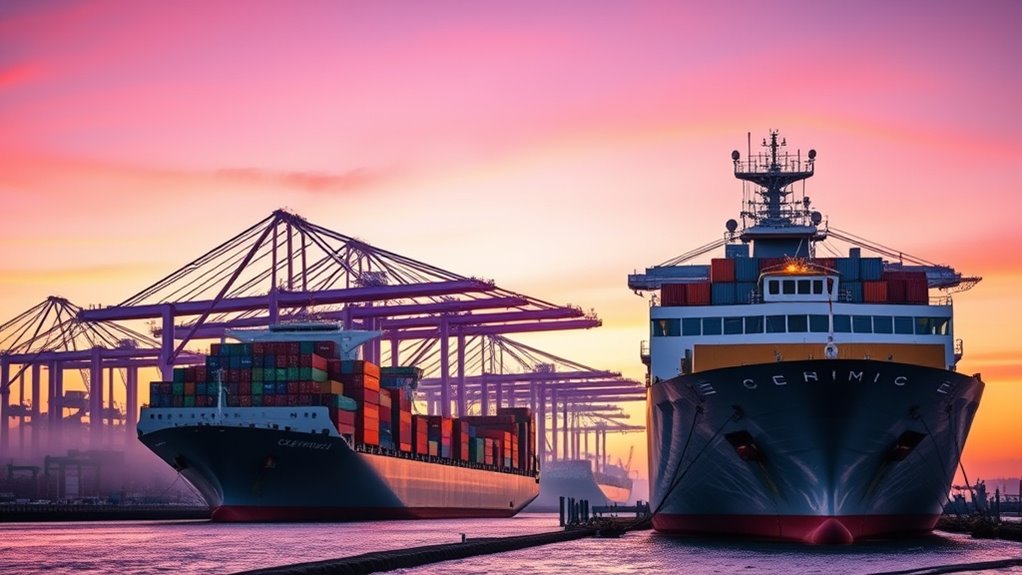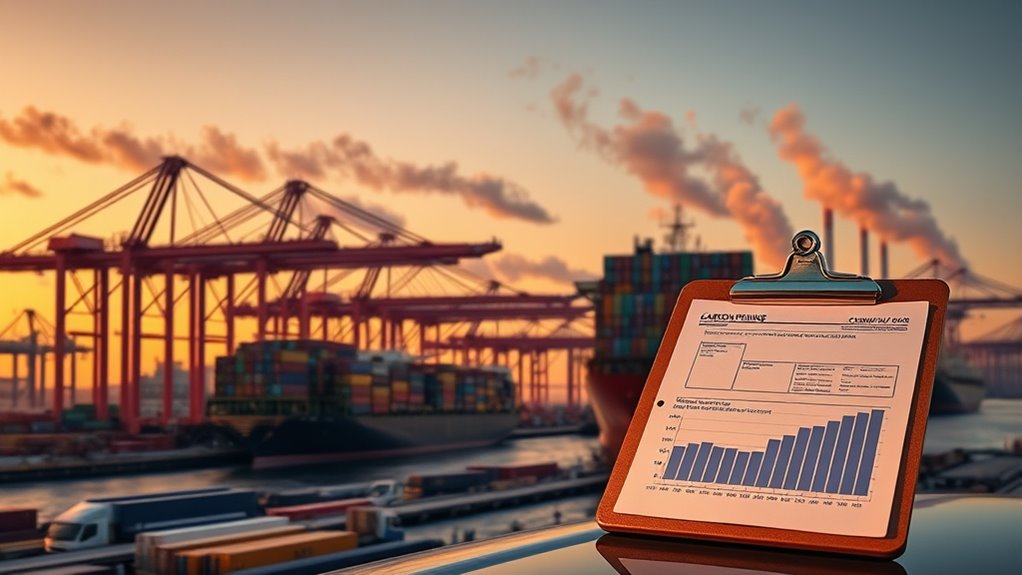Carbon pricing and CBAM can raise costs for your chemical exports by making carbon-intensive goods pricier and increasing compliance requirements. To stay competitive, you’ll need to adopt cleaner technologies, source sustainably, and demonstrate your commitment to reducing emissions. Meeting these regulations not only helps avoid penalties but also boosts your reputation in sustainability-focused markets. If you keep exploring, you’ll discover strategies to navigate these policy shifts and turn challenges into opportunities.
Key Takeaways
- Carbon pricing and CBAM increase costs for carbon-intensive chemical exports, prompting supply chain and process adjustments.
- These policies incentivize investment in cleaner technologies to maintain competitiveness in export markets.
- Demonstrating emission reductions and compliance enhances reputation and access to sustainability-focused regions.
- Exporters face administrative challenges in tracking emissions and adhering to new regulatory documentation requirements.
- Proactively adopting sustainable practices positions chemical companies as industry leaders and opens new market opportunities.

Carbon pricing and the Carbon Border Adjustment Mechanism (CBAM) are powerful tools governments use to encourage industries to reduce their carbon emissions. These policies directly influence trade policy by making carbon-intensive goods more expensive, which pushes industries to innovate and adopt cleaner practices. When it comes to chemical exports, understanding how these mechanisms operate is vital because they can dramatically impact your competitiveness and market access. If your business exports chemicals to regions with strict carbon regulations, you need to be aware that your export costs could rise due to carbon pricing and border adjustments. This may require you to revisit your production processes or supply chain choices to remain viable in these markets.
By integrating emission reduction strategies into your trade policy, you not only comply with regulations but also position yourself as a responsible exporter. Governments implementing carbon pricing aim to internalize the environmental costs of emissions, making carbon-intensive products less attractive on the international stage. For chemical exporters, this means that products with higher carbon footprints may face tariffs or border adjustments that increase their costs. To stay competitive, you might consider investing in cleaner production technologies or sourcing raw materials more sustainably. These changes can help reduce the carbon footprint of your products, potentially avoiding additional charges and opening doors to markets that prioritize sustainability.
Moreover, the impact of CBAM extends beyond just cost considerations. It influences your overall trade strategy by encouraging you to align your operations with global emission reduction goals. This alignment can improve your reputation and appeal to consumers and buyers increasingly concerned about sustainability. Adapting your export practices to meet these standards might involve certification processes or transparency measures that demonstrate your commitment to emission reduction. While this requires upfront investment, it can lead to long-term benefits, such as expanded market access and a stronger competitive edge.
However, these policies also introduce challenges. You may face increased compliance burdens, needing to monitor and document your emissions carefully. Managing these requirements can involve substantial administrative work, but it’s necessary to ensure your exports aren’t penalized or blocked. Collaborating with industry groups or consulting experts can help you navigate this evolving landscape. Additionally, understanding the financial stability of your trading partners and compliance costs can help you better prepare for market shifts. Ultimately, embracing carbon pricing and CBAM as part of your overall trade policy can turn these regulatory measures into opportunities for innovation and leadership in sustainability. By proactively reducing emissions and adapting your export strategies, you position your business not just to survive but to thrive in a greener, more regulated global economy.
Frequently Asked Questions
How Will CBAM Affect Developing Countries’ Chemical Industries?
CBAM may challenge developing countries’ chemical industries by increasing export costs, making their products less competitive. However, it also encourages technology transfer, helping these nations adopt cleaner, more efficient processes. If you leverage support for technology transfer, your chemical sector can innovate and meet new standards, boosting long-term growth. Embracing these changes could turn CBAM into an opportunity rather than a barrier for your developing country’s chemical industry.
What Are the Potential Economic Benefits of Carbon Pricing for Chemical Exporters?
You can gain economic benefits from carbon pricing by boosting innovation incentives and strengthening market competitiveness. When you adopt cleaner technologies early, you set yourself apart from competitors, opening doors to new markets and higher-value products. This proactive approach encourages sustainable growth, reduces costs long-term, and enhances your reputation globally. Embracing carbon pricing isn’t just a challenge; it’s an opportunity to lead in eco-friendly manufacturing and expand your export potential.
How Do Different Countries Implement Carbon Pricing Mechanisms?
You’ll see countries implement carbon pricing through mechanisms like carbon taxes and cap-and-trade systems. A carbon tax directly charges emitters a fee per unit of emissions, encouraging reductions. Cap and trade sets a limit on emissions and allows companies to buy and sell allowances. Each country tailors these approaches based on their policies, economic goals, and industry needs, creating diverse strategies to incentivize lower emissions.
What Legal Challenges Might Arise From CBAM Enforcement?
You might face legal disputes and enforcement challenges when implementing CBAM, as countries could challenge its compatibility with international trade laws or argue it breaches existing agreements. Enforcement issues may arise if customs authorities struggle to verify carbon content accurately or if exporters dispute the measures. These legal uncertainties can slow down enforcement, create disputes, and complicate international cooperation on climate policies.
How Can Chemical Companies Adapt to Changing Carbon Regulations?
Adapting to changing carbon regulations is like steering a river with shifting currents. You should invest in technological innovation to improve your processes and reduce emissions, making your products more compliant. Strengthen your supply chain resilience by diversifying suppliers and sourcing sustainable materials. Stay informed on regulatory updates and advocate for clear policies. Embracing these strategies helps you stay competitive and resilient amidst evolving environmental standards.
Conclusion
Think of carbon pricing and CBAM as the gatekeepers at a bustling trade crossing. They can either slow down your chemical exports or push you to innovate and adapt. Embracing these policies is like planting seeds for a greener future—your resilience and ingenuity will determine whether your exports flourish or falter. Stay proactive, stay sustainable, and turn these challenges into opportunities that lead you through the gates of tomorrow’s market.









